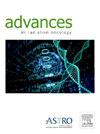旋转强化质子点阵:利用点扫描质子弧疗法的新型点阵技术
IF 2.2
Q3 ONCOLOGY
引用次数: 0
摘要
目的 本研究旨在探讨使用点扫描质子弧(SPArc)进行格子放射治疗的可行性和剂量优势,并与体积调制弧治疗(VMAT)和强度调制质子治疗(IMPT)格子技术进行比较。方法 使用 VMAT、IMPT 和 SPArc 技术,对腹部、骨盆、肺部和头颈部的 14 个大肿瘤进行了格子计划的回顾性生成。晶格几何图形包括直径为 1.5 厘米的顶点,这些顶点排列在以身体为中心的立方晶格中,晶格常数为 6 厘米。处方剂量为 20 Gy(相对生物效应[RBE]),分 5 次照射肿瘤外围,同时以 66.7 Gy(相对生物效应[RBE])的综合增强剂量作为顶点的最小剂量。根据美国医学物理学家协会第 101 任务组的要求,对高危器官限制进行了优先排序。提取剂量-体积直方图并用于确定最大、最小和平均剂量;等效均匀剂量;D95%、D50%、D10%、D5%;V19Gy;峰谷剂量比(PVDR)和梯度指数(GI)。结果平均肿瘤体积为 577 毫升,每个计划的高剂量顶点中位数为 4.5 个。所有计划都保持了低剂量覆盖(中位 V19Gy:SPArc 96%、IMPT 96%、VMAT 92%)。根据 PVDR(SPArc 4.0,IMPT 3.6,VMAT 3.2;SPArc-IMPT P = .0001,SPArc-VMAT P < .001)和高剂量 GI(SPArc 5.9,IMPT 11.7,VMAT 17.1;SPArc-IMPT P = .001,SPArc-VMAT P < .01),SPArc 产生的剂量梯度明显更大。所有计划都符合器官风险限制。结论与 VMAT 和 IMPT 相比,SPArc 疗法能够为不同部位实现高质量的晶格计划,且梯度指标(PVDR 和 GI)更优。值得临床应用。本文章由计算机程序翻译,如有差异,请以英文原文为准。
Rotationally Intensified Proton Lattice: A Novel Lattice Technique Using Spot-Scanning Proton Arc Therapy
Purpose
The aim of this study was to explore the feasibility and dosimetric advantage of using spot-scanning proton arc (SPArc) for lattice radiation therapy in comparison with volumetric-modulated arc therapy (VMAT) and intensity modulated proton therapy (IMPT) lattice techniques.
Methods
Lattice plans were retrospectively generated for 14 large tumors across the abdomen, pelvis, lung, and head-and-neck sites using VMAT, IMPT, and SPArc techniques. Lattice geometries comprised vertices 1.5 cm in diameter that were arrayed in a body-centered cubic lattice with a 6-cm lattice constant. The prescription dose was 20 Gy (relative biological effectiveness [RBE]) in 5 fractions to the periphery of the tumor, with a simultaneous integrated boost of 66.7 Gy (RBE) as a minimum dose to the vertices. Organ-at-risk constraints per American Association of Physicists in Medicine Task Group 101were prioritized. Dose-volume histograms were extracted and used to identify maximum, minimum, and mean doses; equivalent uniform dose; D95%, D50%, D10%, D5%; V19Gy; peak-to-valley dose ratio (PVDR); and gradient index (GI). The treatment delivery time of IMPT and SPArc were simulated based on the published proton delivery sequence model.
Results
Median tumor volume was 577 cc with a median of 4.5 high-dose vertices per plan. Low-dose coverage was maintained in all plans (median V19Gy: SPArc 96%, IMPT 96%, VMAT 92%). SPArc generated significantly greater dose gradients as measured by PVDR (SPArc 4.0, IMPT 3.6, VMAT 3.2; SPArc-IMPT P = .0001, SPArc-VMAT P < .001) and high-dose GI (SPArc 5.9, IMPT 11.7, VMAT 17.1; SPArc-IMPT P = .001, SPArc-VMAT P < .01). Organ-at-risk constraints were met in all plans. Simulated delivery time was significantly improved with SPArc compared with IMPT (510 seconds vs 637 seconds, P < .001).
Conclusions
SPArc therapy was able to achieve high-quality lattice plans for various sites with superior gradient metrics (PVDR and GI) when compared with VMAT and IMPT. Clinical implementation is warranted.
求助全文
通过发布文献求助,成功后即可免费获取论文全文。
去求助
来源期刊

Advances in Radiation Oncology
Medicine-Radiology, Nuclear Medicine and Imaging
CiteScore
4.60
自引率
4.30%
发文量
208
审稿时长
98 days
期刊介绍:
The purpose of Advances is to provide information for clinicians who use radiation therapy by publishing: Clinical trial reports and reanalyses. Basic science original reports. Manuscripts examining health services research, comparative and cost effectiveness research, and systematic reviews. Case reports documenting unusual problems and solutions. High quality multi and single institutional series, as well as other novel retrospective hypothesis generating series. Timely critical reviews on important topics in radiation oncology, such as side effects. Articles reporting the natural history of disease and patterns of failure, particularly as they relate to treatment volume delineation. Articles on safety and quality in radiation therapy. Essays on clinical experience. Articles on practice transformation in radiation oncology, in particular: Aspects of health policy that may impact the future practice of radiation oncology. How information technology, such as data analytics and systems innovations, will change radiation oncology practice. Articles on imaging as they relate to radiation therapy treatment.
 求助内容:
求助内容: 应助结果提醒方式:
应助结果提醒方式:


